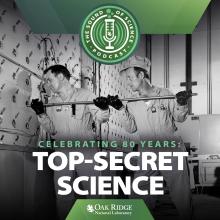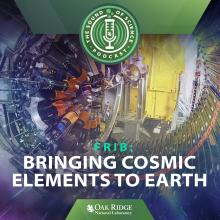Menu
The Sound of Science
A podcast that lets you hear the voices behind the scientific breakthroughs at Oak Ridge National Laboratory.
Listen on Apple Podcasts or use this RSS feed to add a new subscription in any podcast player.

Celebrating 80 Years: A Lab for a New Era
By the early 1990s, Oak Ridge National Laboratory had transformed into a scientific institution with a diverse research portfolio that went well beyond its nuclear roots in the Manhattan Project. But despite this success, the lab was entering a period of uncertainty. Its facilities were showing their age and there were questions about the national labs' role in a post-Cold War world. In this episode, you’ll hear how ORNL evolved to become the modern research complex we know today. You’ll also hear about how these changes positioned the lab to tackle today’s scientific challenges.
Celebrating 80 Years: Meeting the Needs of a Changing World
In the first part of our 80th anniversary series, you heard how the Manhattan Project helped end World War II with the development and use of the world’s first nuclear weapons. The success of this top-secret endeavor ushered in a new era of nuclear science. The expertise used to build the atomic bombs was applied in peacetime to a range of nuclear-inspired research. This research would spawn significant advances in existing fields like chemistry and materials science, and establish completely new ones like neutron scattering and health physics. In this episode, we'll explore the lab's growth and evolution in the decades that followed the war.
Soundbite: Lessons and Legacy - Oppenheimer and The Manhattan Project
As you heard in the last episode, Oak Ridge National Laboratory is celebrating its 80th anniversary. The lab was born out of the Manhattan Project, a top-secret mission that would bring an end to World War II with the production of the world’s first nuclear weapons. Clandestine sites across the country worked unique pieces of the puzzle that would become the atomic bomb. While sites in Oak Ridge, Tennessee, and Hanford, Washington, studied and produced the material for the weapons, scientists in Los Alamos, New Mexico, were focused on the design and assembly of the bomb. Those efforts in Los Alamos were led by renowned physicist J. Robert Oppenheimer – a name that should sound particularly familiar this summer. Oppenheimer was the Manhattan Project mastermind behind the atomic bomb, and now his story is the focus of a new blockbuster film based on the Pulitzer Prize-winning biography, “American Prometheus: The Triumph and Tragedy of J. Robert Oppenheimer,” by Kai Bird and Martin Sherwin. As part of the 80th celebration, Kai Bird recently visited ORNL and joined us for a discussion on the legacy of Oppenheimer and the Manhattan Project.
Celebrating 80 Years: Top-Secret Science
Eighty years ago, the U.S. government embarked on a secret mission that would change the world. The Manhattan Project was a massive effort that resulted in the world’s first nuclear weapons and the end of World War II. But its legacy extends well beyond the war, as it laid the foundation for groundbreaking science for decades to come. Oak Ridge National Laboratory is one of the facilities born out of the Manhattan Project. Over the past 80 years, its mission has evolved and expanded to become a world leader in supercomputing, materials research, isotopes, clean energy — to name a few — but to this day is still strongly associated with its Manhattan Project roots. In this episode, you'll hear the story of the lab's top-secret origin from Alan Icenhour, the lab’s recently retired deputy for operations.
HFIR: Leading the World in Isotopes and Science
For nearly six decades, the High Flux Isotope Reactor, or HFIR, at Oak Ridge National Laboratory has been one of the world’s most powerful research reactors. It has played a critical role in making isotopes for a range of applications, including space exploration, periodic table discoveries and life-saving cancer treatments. However, isotope production isn't HFIR's only claim to fame. The versatile reactor boasts world-class capabilities for neutron scattering, materials testing and analyzing samples at the atomic scale. In this episode, you'll hear from the scientists and engineers who help carry out these missions and ensure the reactor will run for decades to come.
FRIB: Bringing Cosmic Elements to Earth
When the universe was formed billions and billions of years ago, the building blocks of life were forged with it. Hydrogen, carbon, iron, nitrogen, calcium, oxygen are just a few of the elements born from the cosmos that make up life on Earth. There are currently 118 known elements and we use the periodic table to organize and understand them. But straightforward as the periodic table seems, it contains a lot of mysteries. Scientists have catalogued more than 3,000 known isotopes and speculate there are thousands more yet to be discovered. The Facility for Rare Isotope Beams, also known as FRIB, has come online at Michigan State University to help researchers in their quest to create new isotopes and study their exotic behavior. FRIB has been years in the making. In fact, several of the instruments and detectors used originated from a historic facility at Oak Ridge National Laboratory. In this episode, you'll hear from several scientists who have been along for the journey about the history and future of this new facility – and what it means for science and society.
Exascale: The New Frontier of Computing
In May 2022, history was made at Oak Ridge National Laboratory. Frontier, the lab’s newest supercomputer, officially did what no other computer in the world had done before — it crossed the exascale barrier. If you're not familiar with the field of supercomputing, an exascale computer is an incredibly powerful system that is capable of a quintillion calculations per second. Frontier’s arrival marks a new era of computational performance that will help enable scientific breakthroughs never before possible. But this milestone didn't happen overnight. The journey to Frontier has been years in the making, with plenty of challenges and dramatic moments along the way. In this episode, you'll hear a behind-the-scenes account of what it took to launch the world’s first exascale computer.
Charging Up The Future of Transportation
Electrifying transportation is key to cutting carbon emissions. However, cumbersome cables, lengthy charge times and range anxiety have some potential electric vehicle adopters hesitant to make the switch. Scientists at Oak Ridge National Laboratory are working to make those concerns a thing of the past with a high-power wireless charging technology that could make powering an EV as easy, or easier, than gassing up a car. In this episode you'll hear from the scientists leading this technology, as well as industry partners working with the team to advance the technology and get it to market.
Soundbite: MPEX: Power, particles and plasma
Soundbite: In our last episode, you heard about how scientists are working to harness the power of the sun on earth with fusion. Achieving fusion on a large scale could bring about a new age of unlimited, carbon-free energy. Scientists are getting closer to making this a reality, but there are still a few hurdles to overcome. One of those is finding materials that can withstand the insane conditions of a fusion reaction. Oak Ridge National Laboratory already has unique capabilities for testing these materials with the High Flux Isotope Reactor, or HFIR. While a fission reactor like HFIR produces some pretty extreme conditions, it’s still no match for what a material will experience inside a fusion reactor. That’s where the Material Plasma Exposure eXperiment, or MPEX, project at ORNL comes in. Hear how scientists like Juergen Rapp will use MPEX to take materials testing to the next level.
Fusion: Energy at the Extreme
Building a sun on Earth to produce unlimited, carbon-free energy may sound like science fiction, but it's not. It's a nuclear process called fusion, where two atoms join together and create an abundance of energy. Recreating the power of a star is no easy feat, but scientists across the globe are hard at work to make it a reality. From materials, to confining sun-hot plasmas, to fuel, there are a lot of scientific challenges to overcome to build a fusion reactor. In this episode, we talked to several Oak Ridge National Laboratory scientists about how they are tackling these problems and why the future of fusion looks brighter than ever right now.











